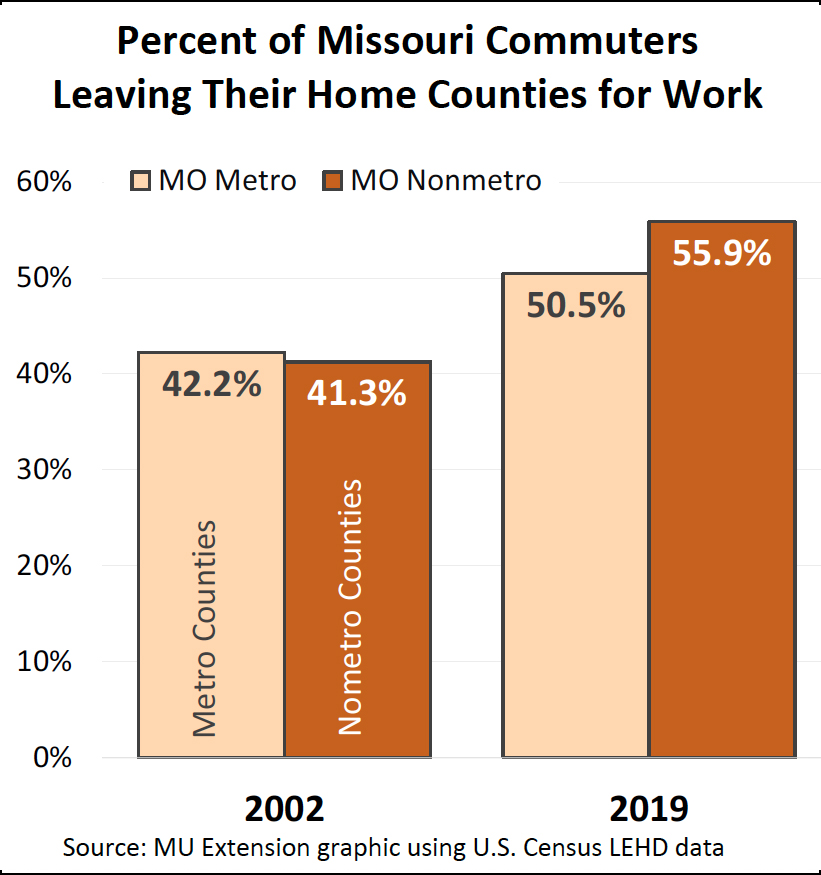Study shows more Missourians commuting outside their counties for work

COLUMBIA, Mo. — While the past two years have fueled growth in remote work, most workers in Missouri still commute to their jobs.
Some are opting for longer commutes. A new report from University of Missouri Extension shows that more workers in the state are commuting to jobs outside their home counties compared to 20 years ago.
According to the report, about four in 10 workers in Missouri worked outside their home counties in 2002. As of 2019, a little more than half of Missouri’s workers were “out-commuting” – crossing county lines to get to their jobs.
This trend has implications for economic development efforts, says Alan Spell, co-author of the report and assistant extension professor at MU’s Exceed – Regional Economic and Entrepreneurial Development program (extension.missouri.edu/exceed). The two-page downloadable brief, written by Spell and research project analyst Justin Krohn, is part of Exceed’s Missouri Economy Indicators series.
Out-commuting grew significantly in both metropolitan and nonmetropolitan counties over the last two decades, but that growth was markedly higher in nonmetro counties. While the proportion of out-commuters in 2002 was about the same for metro and nonmetro counties – 42.2% and 41.3%, respectively – those numbers had diverged sharply by 2019, when 50.5% of workers in metro counties were out-commuting, compared to 55.9% of workers in nonmetro counties.
This increase is consistent with trends throughout the U.S., Spell says, though the growth of out-commuting in Missouri has outpaced the national average.
“Job opportunities have increasingly migrated to our towns and cities as businesses seek larger markets and labor pools,” he says. “Yet many people choose to live in more rural settings, so commuting becomes a part of their workday.”
For communities, businesses and employers, this trend demonstrates the importance of “thinking regionally,” according to Spell and Krohn.
“While city and county boundaries matter for governance, businesses don’t stop recruiting workers at the county line,” Spell says. “Companies are having a hard time filling open job positions. Community leaders who understand their regional worker flows can better support these firms. For example, if businesses across a region need skilled labor – nurses, welders, etc. – then communities can work together to promote these careers and engage with area training providers.”
Data for the brief came from the U.S. Census Bureau’s Longitudinal Employer-Household Dynamics program.
Spell notes that it’s too soon to tell how the rise of remote work might affect commuting patterns, adding that remote work is an option only for a minority of workers. Remote work trends are examined in a December 2021 Missouri Economy Indicators brief from Exceed.
New briefs are available every few weeks. They are part of an MU Extension program started in 2020, at the onset of the pandemic, to report on key Missouri indicators. To receive future briefs, sign up for the Exceed newsletter at tinyurl.com/ExceedUpdates. Past briefs in the series are available at tinyurl.com/ExceedEconomyIndicators.
MU Extension’s Center for Applied Research and Engagement Systems has interactive maps illustrating commuting inflow and outflow by county and census tract in the center’s Missouri Map Room. Visit cares.page.link/F1QW.
Miss Clipping Out Stories to Save for Later?
Click the Purchase Story button below to order a print of this story. We will print it for you on matte photo paper to keep forever.

